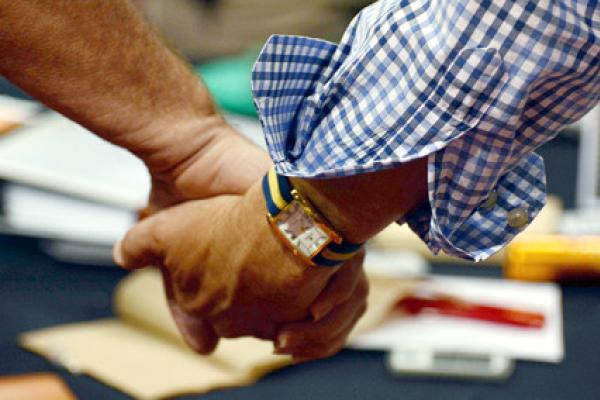The quaint Pillar Church sits directly across the street from Hope College in Holland, Mich. — the first congregation established by a wave of Dutch immigrants to the area. When I enrolled at Hope in 1963, all I knew was that virtually no students went to Pillar Church.
A half century later, the story of Pillar Church tells a much larger narrative of the long and arduous journey toward authentic Christian unity.
Pillar Church and Hope College were both founded as part of the Reformed Church in America, a denomination formed by Dutch settlers to New Amsterdam (we now call it New York City) in 1628. A later wave of Dutch immigrants settled in the Midwest, particularly western Michigan. Some of them broke away and established the Christian Reformed Church in North America in 1857.
From its founding, Pillar Church had been a member of the RCA. But in 1882, a group siding with the emerging CRC seized the church building, locked its doors with chains, and, grasping axe handles, defended it against their fellow congregants. From then on, Pillar Church was a CRC congregation, and it became essentially foreign territory to those of us at the RCA-affiliated school across the street.
One would think that sharply defined theological differences among Reformed Protestants — who are famous for their theological exactitude — would have been the cause of such a dramatic intra-ethnic split. But no. It had more to do with:
- Should we sing hymns in church services, or only Psalms?
- How frequently should we give catechetical instruction to young people?
- Can members belong to fraternal societies like the Freemasons?
Such differences were not always civil, and as the Pillar Church story shows, “church-dividing” took on a literal meaning.
In the century and a half following their formation, the RCA and the CRC maintained remarkably separate identities and cultures. RCA-CRC marriages could split families. The CRC has a proud and strong network of Christian schools; the RCA generally supports public education. That reinforced separate identities among its youth.
And that’s not even mentioning the fierce Division III basketball rivalry between Hope and the CRC’s flagship school, Calvin College.
When I began serving as the RCA’s general secretary in 1994, the relationship between our two bodies could be described as “diplomatic.” Theological differences were nearly impossible to identify. Variations in our internal cultures supported active stereotypes of one another. We were like estranged cousins — same family, but we barely knew one another.
As an ecumenical practice, working together can help redefine how we live together — over the years, the two churches have launched more than 50 joint efforts. But as in every strained relationship, there comes a time when past pain must be confessed, present realities must be acknowledged, and future commitments must be embraced.
Which leads us to Pella, Iowa, last week.
For the first time in 157 years, the CRC’s Synod and the RCA’s General Synod met in a joint business session on the campus of Central College. Some 500 delegates sat at round tables inside the campus gym examining the past and looking to the future. One CRC delegate said he was told, growing up, that the RCA was like “the great Satan,” and asked for forgiveness. An RCA pastor confessed his memories of being firmly instructed never to date a girl from the CRC.
Delegates were presented with a proposal to adopt the so-called “Lund Principle,” which originated out of a World Council of Churches gathering in 1952. The document has captured the ecumenical imagination for half a century, particularly its call to “act together in all matters except those in which deep differences of conviction compel us to act separately.”
The Lund Principle flips the paradigm of ecumenical relationships, asserting that the starting point is always acting together, and demanding a conviction to justify acting apart. The proposal resonated among the delegates, and in good Reformed fashion, they even tried to amend it. In the end it was adopted in a miraculously unanimous vote.
Our current political culture that normalizes polarization and demonization of the opponent has infiltrated the contemporary church culture. Religious news is full of groups all too ready to cut themselves off from others in an attempt to defend their perceived purity. In time, the issues that seem to be “church dividing” may well be seen as inconsequential — just as we scratch our heads about people defending their church with axes almost 150 years ago.
In Pella, it was clear that people yearn for expressions of unity that heal divisions, rather than inflaming them.
Back in Michigan, Pillar Church recently decided to become a joint congregation of the RCA and the CRC, calling a pastor from each denomination. And they built a new baptismal font. Its base is made from chains and axe handles. It’s placed at the entrance to the church, now welcoming all who come.
Wes Granberg-Michaelson is the author of From Times Square to Timbuktu: The Post-Christian West Meets the Non-Western Church . For 17 years he served as General Secretary of the Reformed Church in America, and has long been active in ecumenical initiatives such as the Global Christian Forum and Christian Churches Together. He’s been associated with the ministry of Sojourners for 40 years.
Got something to say about what you're reading? We value your feedback!
